Design and Force/Angle Independent Control of a Bionic Mechanical Ankle Based on an Artificial Muscle Matrix
Abstract
1. Introduction
2. Design and Fabrication of the Smart Digital Structure (SDS)
3. Method
3.1. Modeling of the SDS
3.2. Shrinkage Performance under Constant Loads
4. Results
4.1. Experimental Setup
4.2. Angle of the Bionic Mechanical Ankle
4.3. Torque of the Bionic Mechanical Ankle
4.4. Matrix Control of the Bionic Mechanical Ankle
4.5. Bionic Joint Performance Comparison
5. Conclusions
Author Contributions
Funding
Institutional Review Board Statement
Data Availability Statement
Conflicts of Interest
Appendix A
| Description (Parameter) | Value (Unit) | Description (Parameter) | Value (Unit) |
|---|---|---|---|
| Number of the SMA wires () | 8 | Martensitic transformation start temperature () | 54.5 °C |
| Diameter of the SMA wires () | 0.15 mm | Martensitic transformation finish temperature () | 41.4 °C |
| Length of the SMA wires () | 80 mm | Austenitic Young’s modulus () | 83 GPa |
| Resistance per meter () | 57 Ω/m | Martensitic Young’s modulus () | 28 GPa |
| Density of the SMA wires () | 6.45 g/cm3 | Maximum residual strain () | 5% |
| Specific heat capacity () | 837 J/(kg·°C) | Effect of stress on austenitic transformation () | 12 MPa/°C |
| Latent heat of transformation () | 24.2 × 103 J/kg | Effect of stress on martensitic transformation () | 10 MPa/°C |
| Supply current () | 1.2 A | SMA initial martensite fraction () | 1 |
| Austenite transformation start temperature () | 71.5 °C | Spring stiffness () | 500 N/m |
| Austenite transformation finish temperature () | 79.7 °C | Ambient temperature () | 25 °C |
References
- Zhang, J.J.; Yin, Y.H. SMA-based bionic integration design of self-sensor-actuator-structure for artificial skeletal muscle. Sens. Actuators A-Phys. 2012, 181, 94–102. [Google Scholar] [CrossRef]
- Jeong, J.; Hyeon, K.; Jang, S.-Y.; Chung, C.; Hussain, S.; Ahn, S.-Y.; Bok, S.-K.; Kyung, K.-U. Soft Wearable Robot with Shape Memory Alloy (SMA)-Based Artificial Muscle for Assisting with Elbow Flexion and Forearm Supination/Pronation. IEEE Robot. Autom. Lett. 2022, 7, 6028–6035. [Google Scholar] [CrossRef]
- Narayan, J.; Kalani, A.; Dwivedy, S.K. Reference Trajectory based Jacobian Transpose Control of a Novel Lower Limb Exoskeleton System for Children. In Proceedings of the 2019 5th IEEE International Conference on Signal Processing, Computing and Control (Ispcc 2k19), Solan, India, 10–12 October 2019; pp. 102–107. [Google Scholar]
- Ye, J. Design and implementation of a wearable exoskeleton system for lower limbs. In Proceedings of the IOP Conference Series: Materials Science and Engineering, Xishuangbanna, China, 22–23 June 2019; IOP Publishing: Bristol, UK, 2019. [Google Scholar]
- Chipka, J.; Meller, M.A.; Volkov, A.; Bryant, M.; Garcia, E. Linear dynamometer testing of hydraulic artificial muscles with variable recruitment. J. Intell. Mater. Syst. Struct. 2017, 28, 2051–2063. [Google Scholar] [CrossRef]
- Chipka, J.B.; Meller, M.A.; Garcia, E. Efficiency testing of hydraulic artificial muscles with variable recruitment using a linear dynamometer. Bioinspir. Biomim. Bioreplication 2015, 2015, 9429. [Google Scholar]
- Ning, D.; Che, J.; Zhang, Z.; Tian, H.; Hou, J.; Gong, Y. Position/force control of master-slave antagonistic joint actuated by water hydraulic artificial muscles. Int. J. Adv. Robot. Syst. 2019, 16, 1729881419853981. [Google Scholar] [CrossRef]
- Zhang, Z.; Hou, J.; Ning, D.; Gong, X.; Gong, Y. Modeling and experiments on the drive characteristics of high-strength water hydraulic artificial muscles. Smart Mater. Struct. 2017, 26, 055023. [Google Scholar] [CrossRef]
- Ashwin, K.P.; Ghosal, A. A Survey on Static Modeling of Miniaturized Pneumatic Artificial Muscles with New Model and Experimental Results. Appl. Mech. Rev. 2018, 70, 040802. [Google Scholar] [CrossRef]
- Hashimoto, Y.; Nakanishi, Y.; Saga, N.; Nagase, J.Y.; Satoh, T. Development of Gait Assistive Device Using Pneumatic Artificial Muscle. In Proceedings of the 2016 Joint 8th International Conference on Soft Computing and Intelligent Systems (SCIS) and 17th International Symposium on Advanced Intelligent Systems (ISIS), Sapporo, Japan, 25–28 August 2016; pp. 710–713. [Google Scholar]
- Mohri, S.; Inose, H.; Yokoyama, K.; Yamada, Y.; Kikutani, I.; Nakamura, T. Development of Endoskeleton Type Knee Auxiliary Power Assist Suit using Pneumatic Artificial Muscles. In Proceedings of the 2016 IEEE International Conference on Advanced Intelligent Mechatronics (AIM), Banff, AB, Canada, 12–15 July 2016; pp. 107–112. [Google Scholar]
- Yan, X.; Qin, F.; Hua, L. Kinematic and quasi-static analysis model of a novel variable stiffness pneumatic artificial muscle. Sens. Actuators A-Phys. 2021, 329, 112815. [Google Scholar]
- Cao, C.J.; Gao, X.; Conn, A.T. Towards efficient elastic actuation in bio-inspired robotics using dielectric elastomer artificial muscles. Smart Mater. Struct. 2019, 28, 095015. [Google Scholar] [CrossRef]
- Novelli, G.L.; Vargas, G.G.; Andrade, R.M. Dielectric elastomer actuators as artificial muscles for wearable robots. J. Intell. Mater. Syst. Struct. 2022, 34, 1007–1025. [Google Scholar] [CrossRef]
- Palaniswamy, M.; Herzog, M.; Panwar, S.; Jones, M.; Rowe, M. Increasing performance of soft dielectric elastomer artificial muscles via nanomaterial composite electrical insulators. MRS Adv. 2022, 7, 533–537. [Google Scholar] [CrossRef]
- Qiu, Y.; Zhang, E.; Plamthottam, R.; Pei, Q. Dielectric Elastomer Artificial Muscle: Materials Innovations and Device Explorations. Acc. Chem. Res. 2019, 52, 316–325. [Google Scholar] [CrossRef] [PubMed]
- Haines, C.S.; Lima, M.D.; Li, N.; Spinks, G.M.; Foroughi, J.; Madden, J.D.W.; Kim, S.H.; Fang, S.; Jung de Andrade, M.; Göktepe, F.; et al. Artificial Muscles from Fishing Line and Sewing Thread. Science 2014, 343, 868–872. [Google Scholar] [CrossRef] [PubMed]
- Jani, J.M.; Leary, M.; Subic, A.; Gibson, M.A. A review of shape memory alloy research, applications and opportunities. Mater. Des. 2014, 56, 1078–1113. [Google Scholar] [CrossRef]
- Peng, C.; Yin, Y.H.; Hong, H.B.; Zhang, J.J.; Chen, X. Bio-inspired design methodology of sensor-actuator-structure integrated system for artificial muscle using SMA. In Proceedings of the 3rd Cirp Conference on Biomanufacturing, Chicago, IL, USA, 11–14 July 2017; Volume 65, pp. 299–303. [Google Scholar]
- Park, S.J.; Kim, U.; Park, C.H. A Novel Fabric Muscle Based on Shape Memory Alloy Springs. Soft Robot. 2020, 7, 321–331. [Google Scholar] [CrossRef] [PubMed]
- Kaal, W.; Herold, S. Electroactive Polymer Actuators in Dynamic Applications. IEEE-ASME Trans. Mechatron. 2011, 16, 24–32. [Google Scholar] [CrossRef]
- Rosset, S.; Shea, H.R. Flexible and stretchable electrodes for dielectric elastomer actuators. Appl. Phys. A-Mater. Sci. Process. 2013, 110, 281–307. [Google Scholar] [CrossRef]
- Xu, H.; Pei, Y.; Fang, D.; Ai, S. An energy-based dynamic loss hysteresis model for giant magnetostrictive materials. Int. J. Solids Struct. 2013, 50, 672–679. [Google Scholar] [CrossRef]
- Zhou, H.Q.; Cao, S.Z.; Ma, N. Design and performance analysis of a novel class of SMA-driven rotational mechanisms/joints. Robotica 2022, 40, 3976–3994. [Google Scholar] [CrossRef]
- Barbarino, S.; Flores, E.S.; Ajaj, R.M.; Dayyani, I.; Friswell, M.I. A review on shape memory alloys with applications to morphing aircraft. Smart Mater. Struct. 2014, 23, 063001. [Google Scholar] [CrossRef]
- Colorado, J.; Rossi, C.; Zhang, C.; Barrientos, A. Towards efficient flight: Insights on proper morphing-wing modulation in a bat-like robot. Adv. Robot. 2015, 29, 1599–1610. [Google Scholar] [CrossRef][Green Version]
- Copaci, D.S.; Blanco, D.; Martin-Clemente, A.; Moreno, L. Flexible shape memory alloy actuators for soft robotics: Modelling and control. Int. J. Adv. Robot. Syst. 2020, 17, 1729881419886747. [Google Scholar] [CrossRef]
- Jin, H.; Dong, E.; Alici, G.; Mao, S.; Min, X.; Liu, C.; Low, K.H.; Yang, J. A starfish robot based on soft and smart modular structure (SMS) actuated by SMA wires. Bioinspir. Biomim. 2016, 11, 056012. [Google Scholar] [CrossRef] [PubMed]
- Guo, Z.; Yin, Y.H. A dynamic model of skeletal muscle based on collective behavior of myosin motors-Biomechanics of skeletal muscle based on working mechanism of myosin motors (I). Sci. China-Technol. Sci. 2012, 55, 1589–1595. [Google Scholar] [CrossRef]
- Liang, C.; Rogers, C.A. Design of shape memory alloy actuators (Reprinted from Journal of Mechanical Design, vol 114, pg 223–230, 1993). J. Intell. Mater. Syst. Struct. 1997, 8, 303–313. [Google Scholar] [CrossRef]
- Hao, L.N.; Xiang, C.Q.; Peng, Y.; Xu, X.Y.; Wang, Q.L. Design and Simulation of a PAM Based Bionic Elbow Joint. Appl. Mech. Mater. 2014, 461, 589–596. [Google Scholar] [CrossRef]
- Cui, B.Y.; Chen, L.W.; Xie, Y.T.; Hu, Y.D. Static decoupling performance analysis and design of bionic elbow joint. J. Biomim. Biomater. Biomed. Eng. 2018, 36, 34–44. [Google Scholar] [CrossRef]
- Lohse, F.; Wende, C.; Klass, K.D.; Hickmann, R.; Häntzsche, E.; Bollengier, Q.; Ashir, M.; Pöschel, R.; Bolk, N.; Trümper, W.; et al. Bio-inspired semi-flexible joint based on fibre-reinforced composites with shape memory alloys. J. Intell. Mater. Syst. Struct. 2021, 32, 462–472. [Google Scholar] [CrossRef]
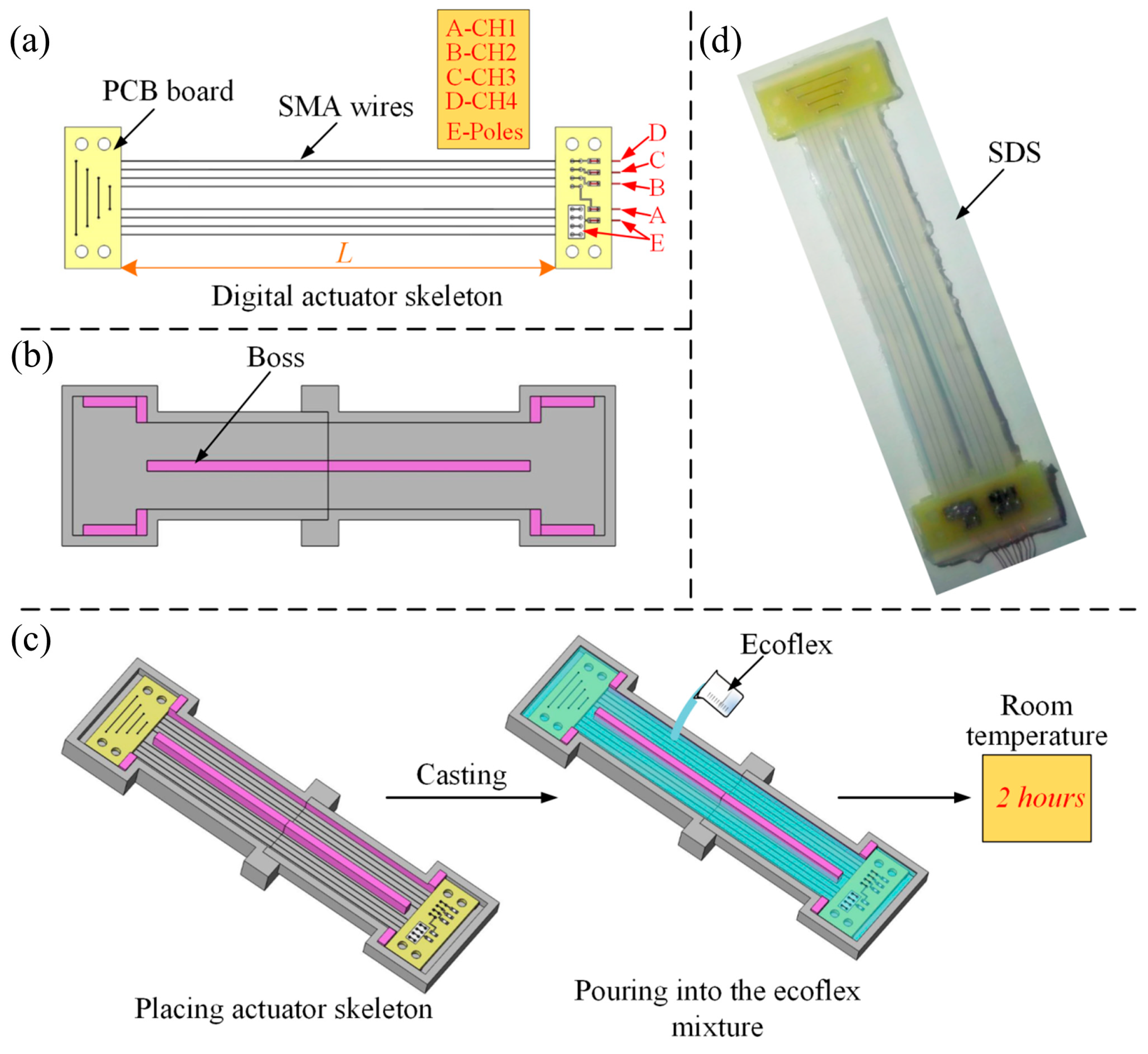

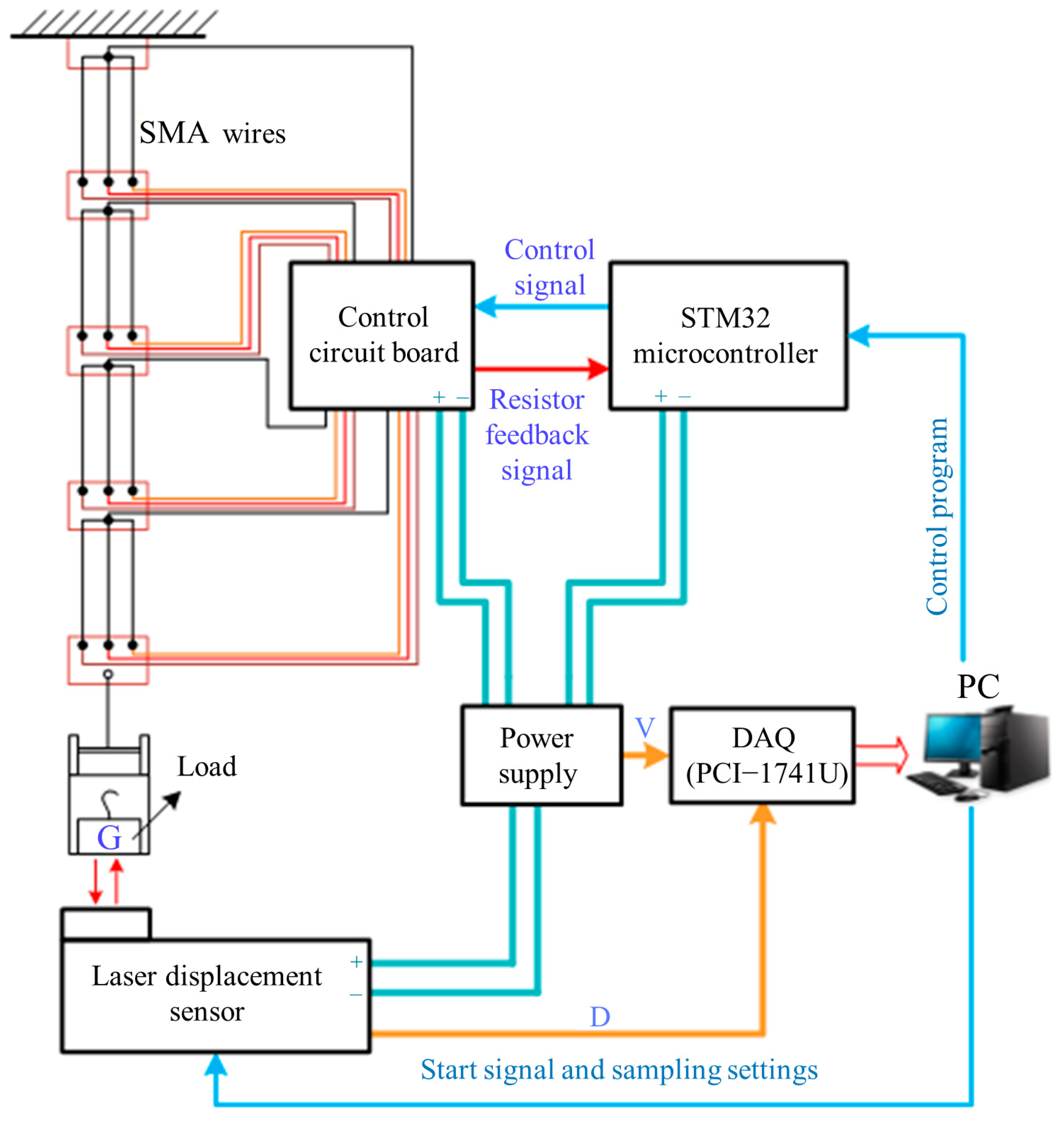
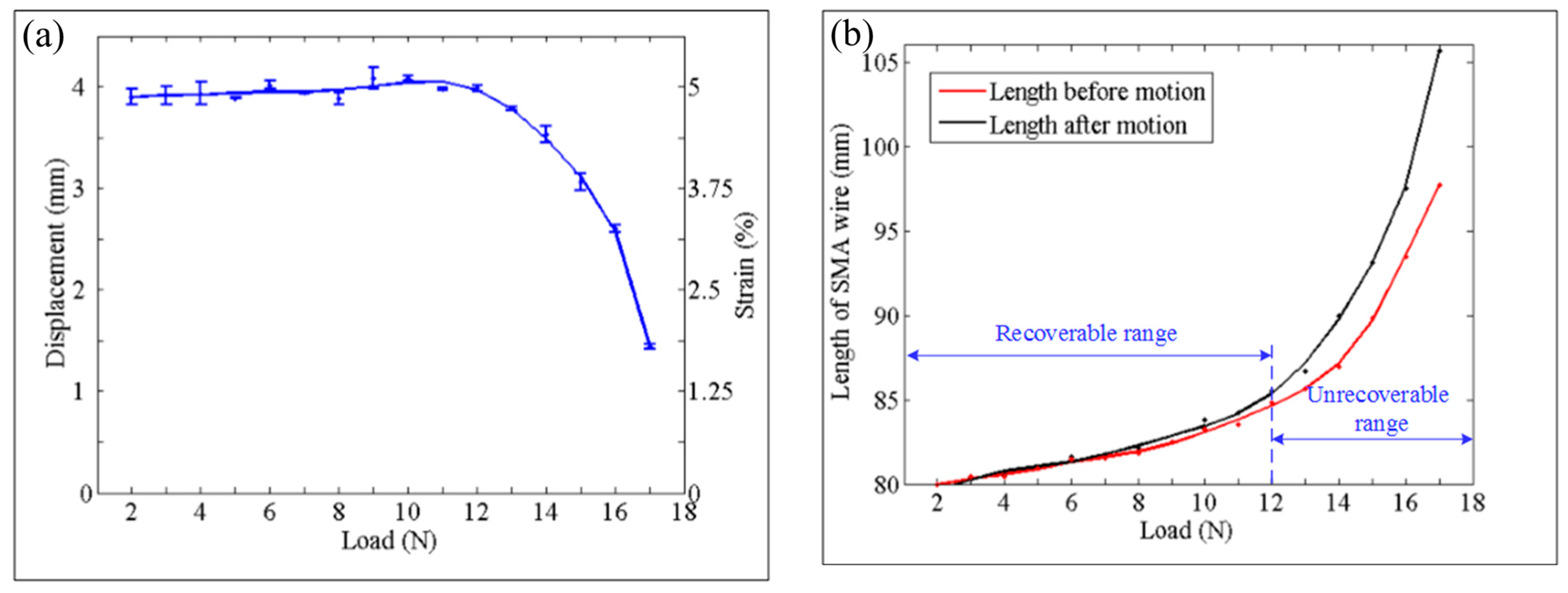
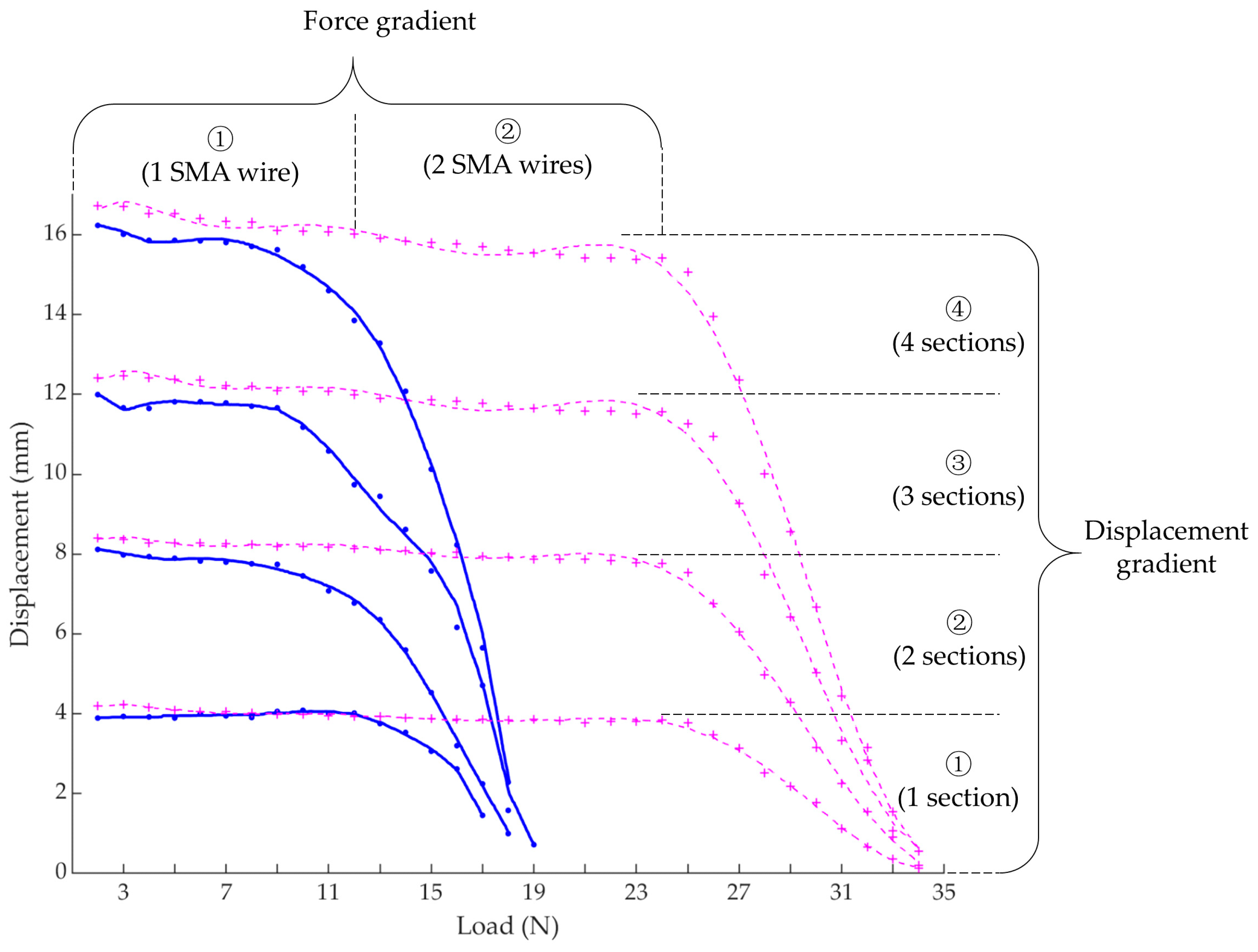
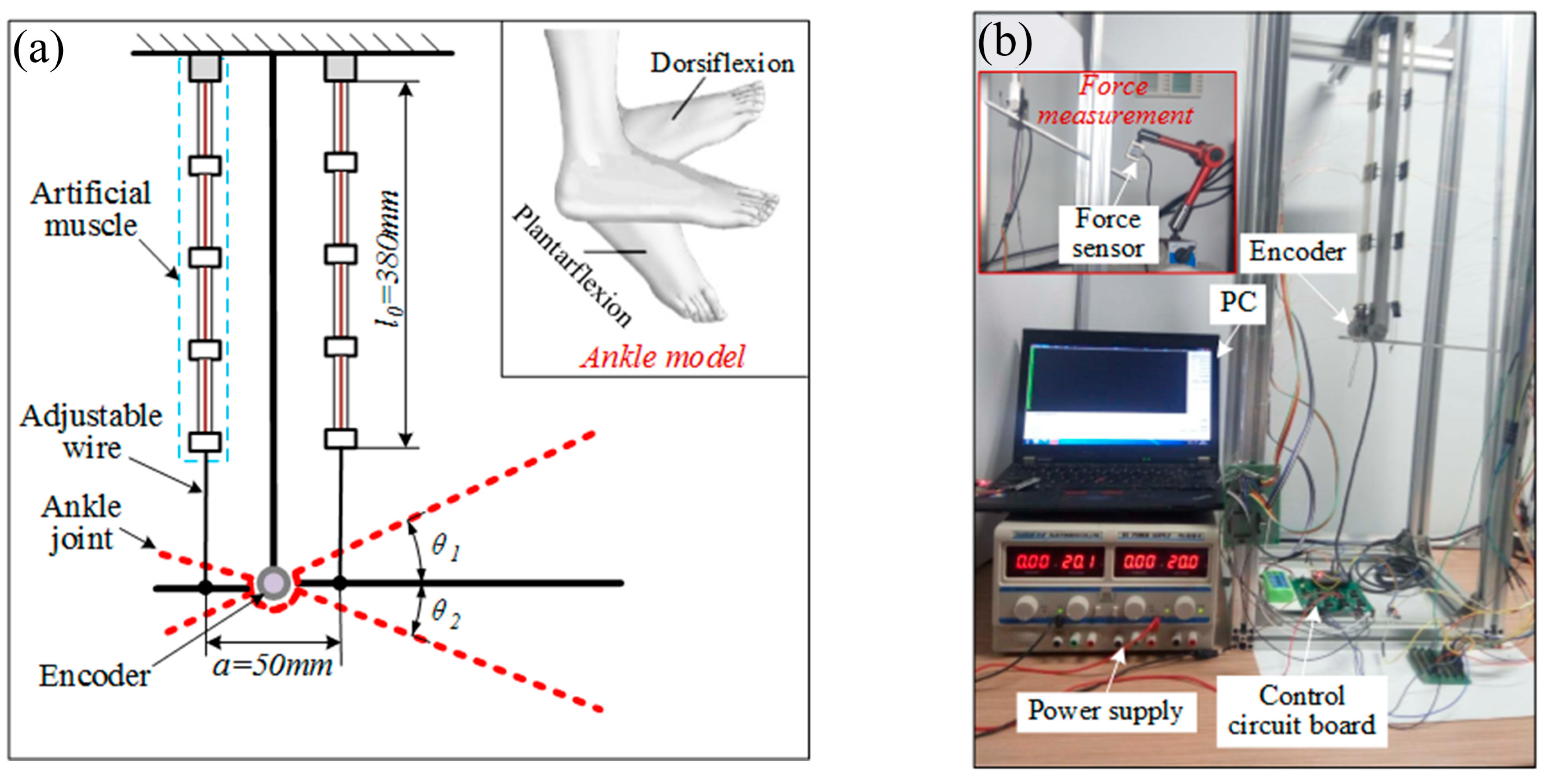
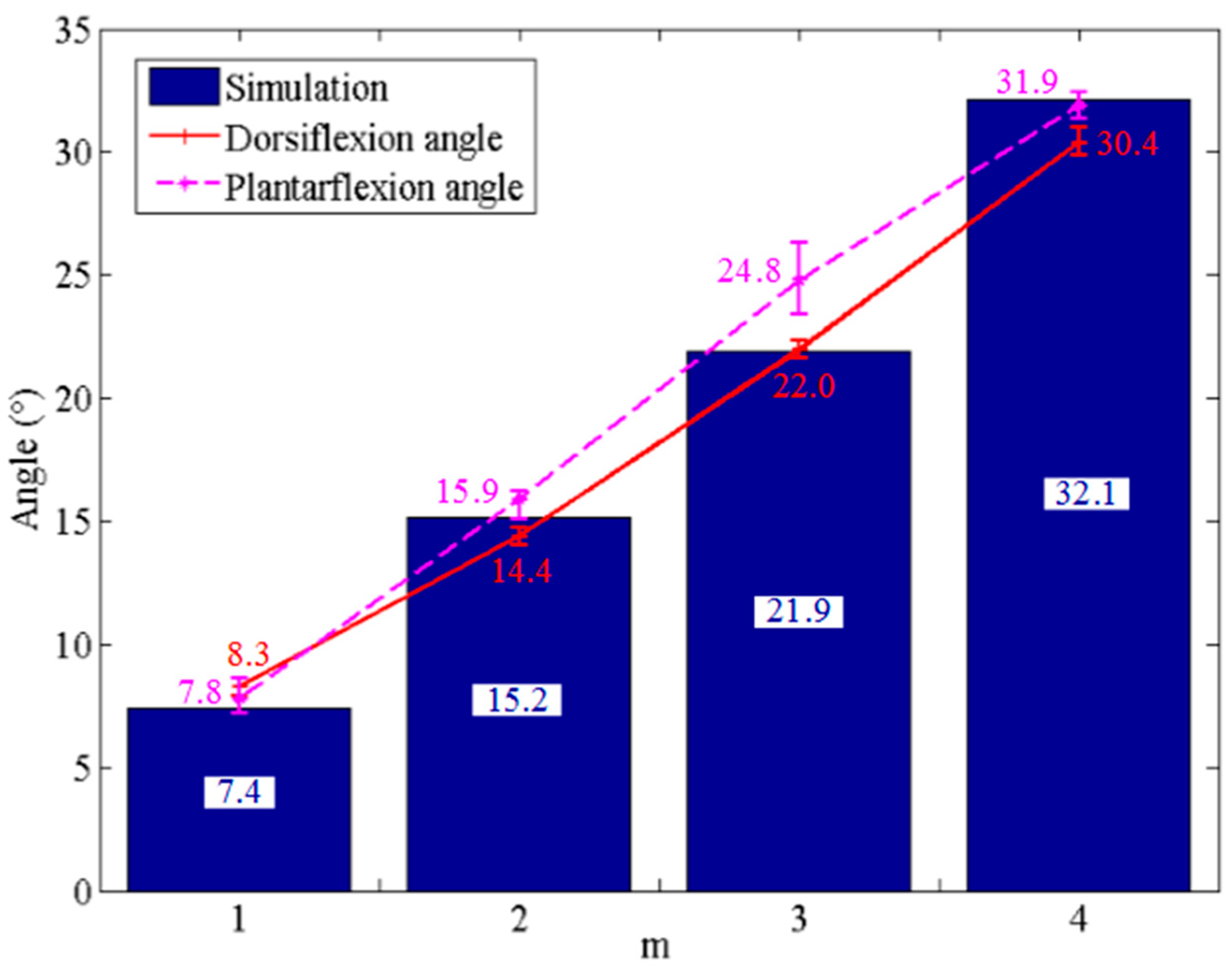
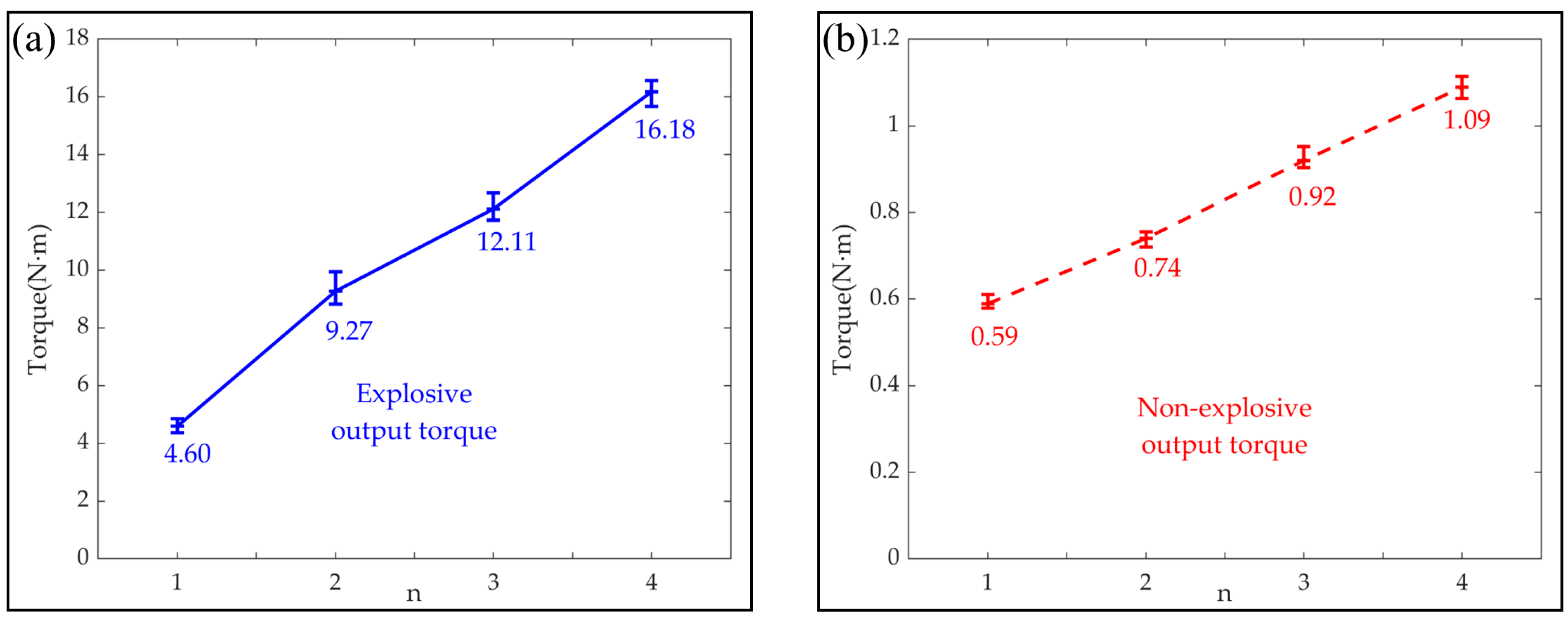
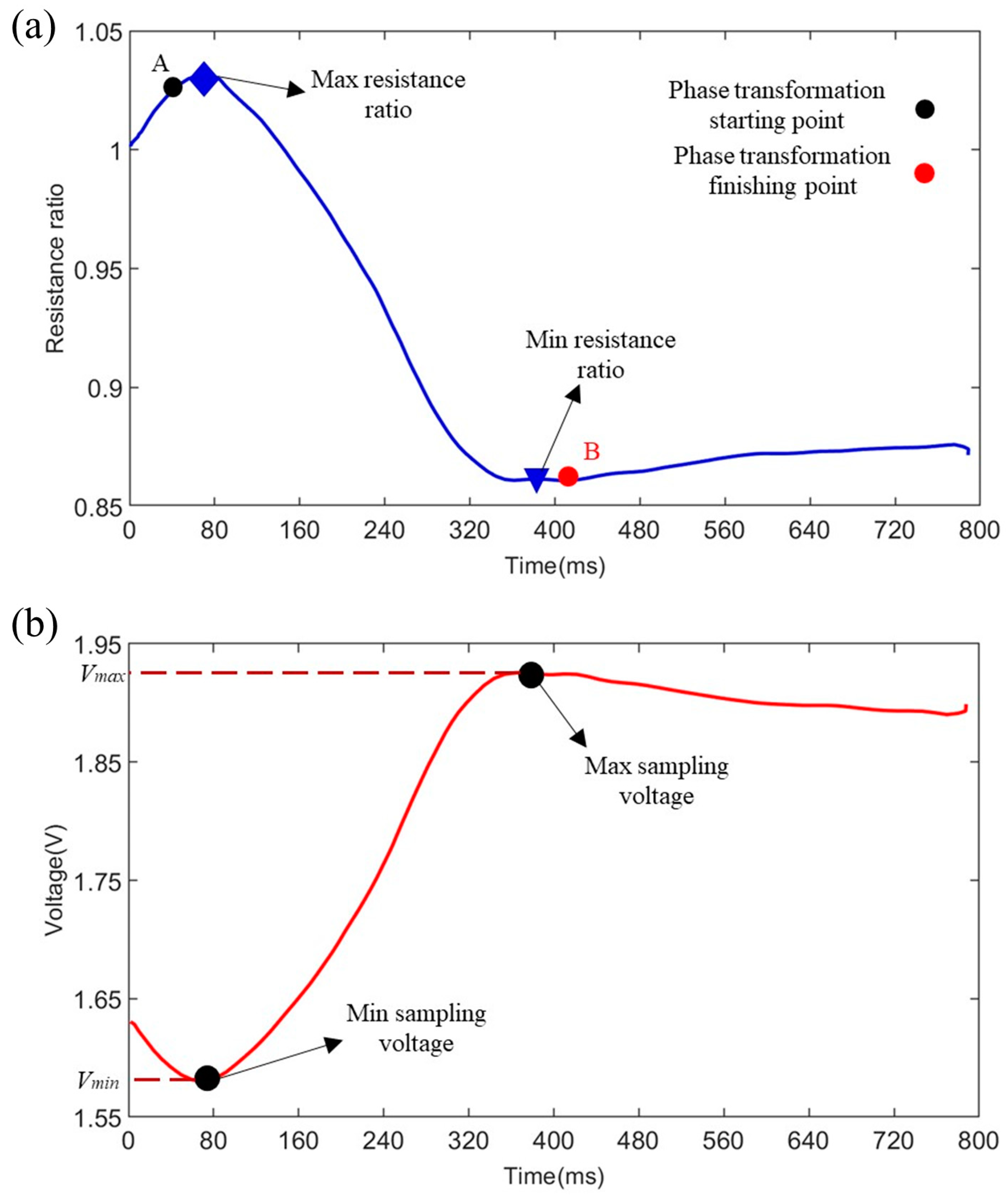
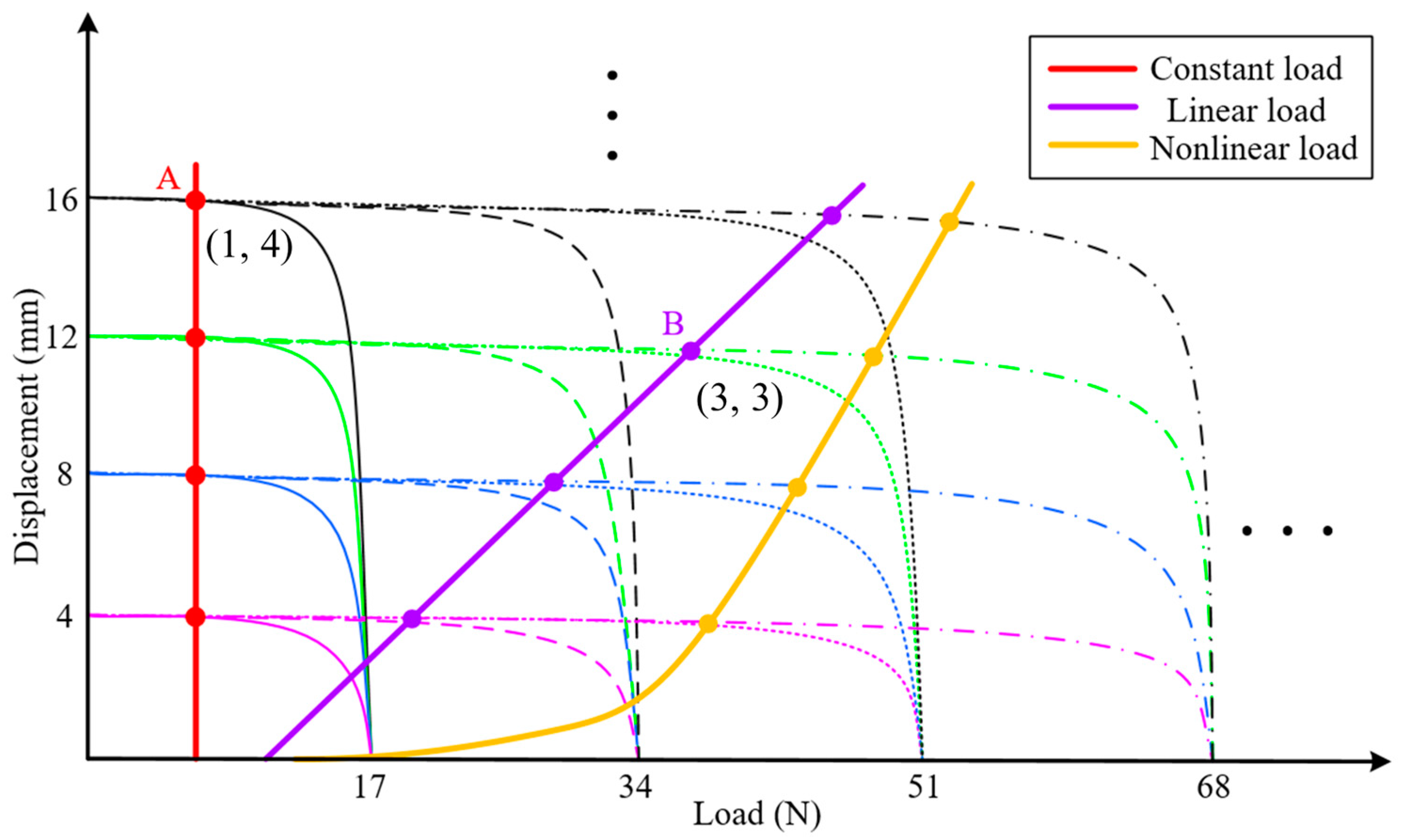
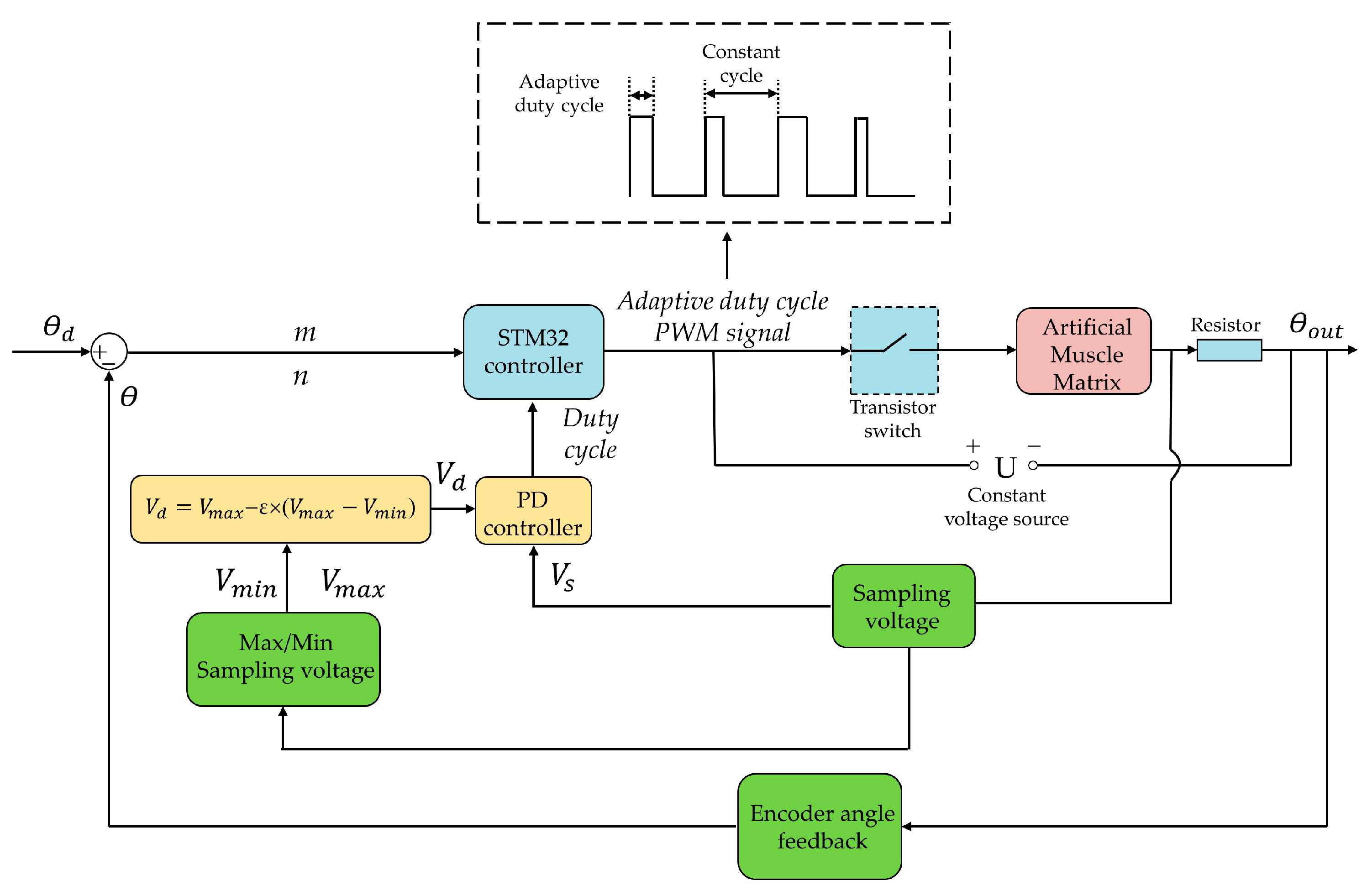
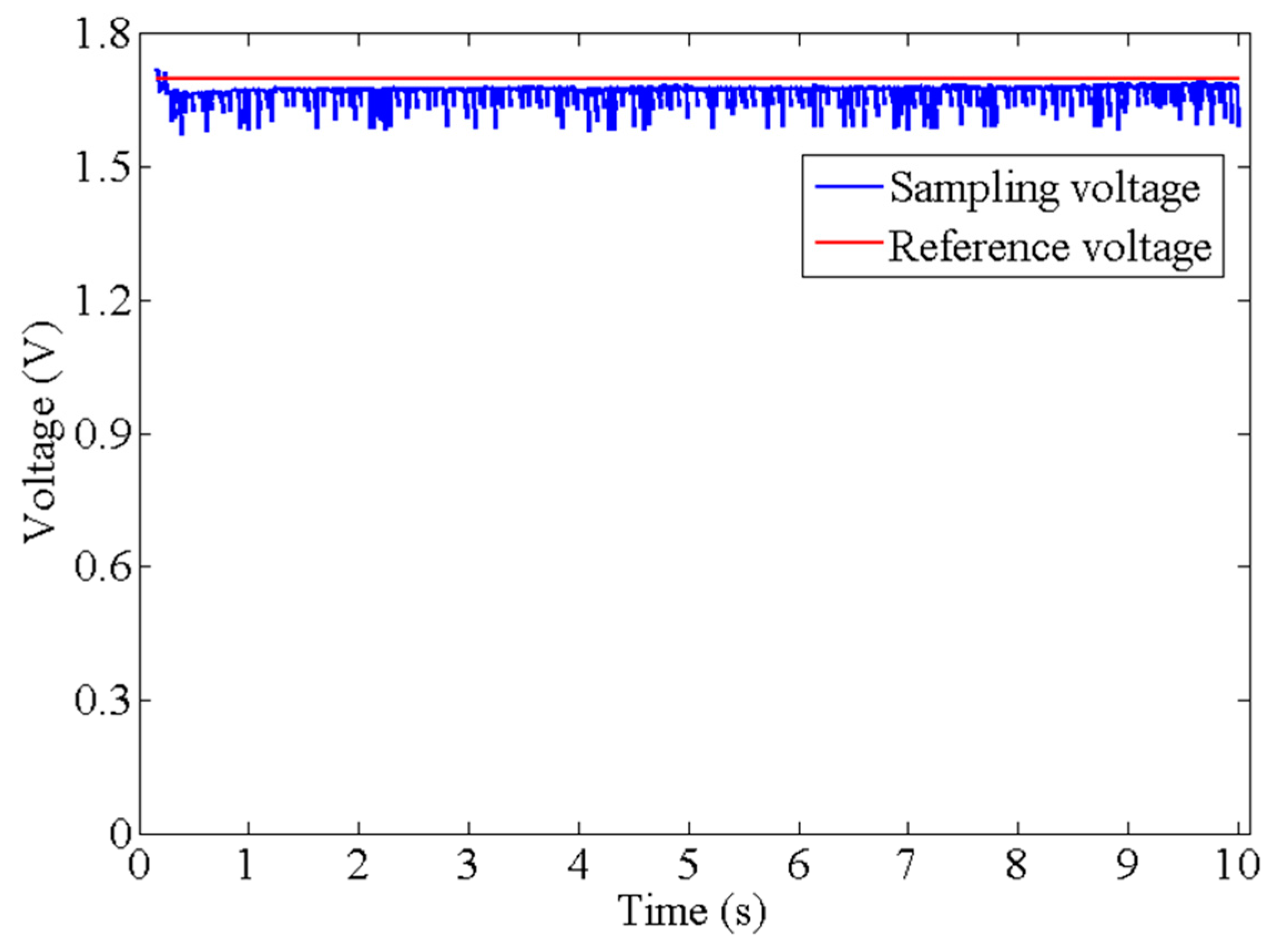
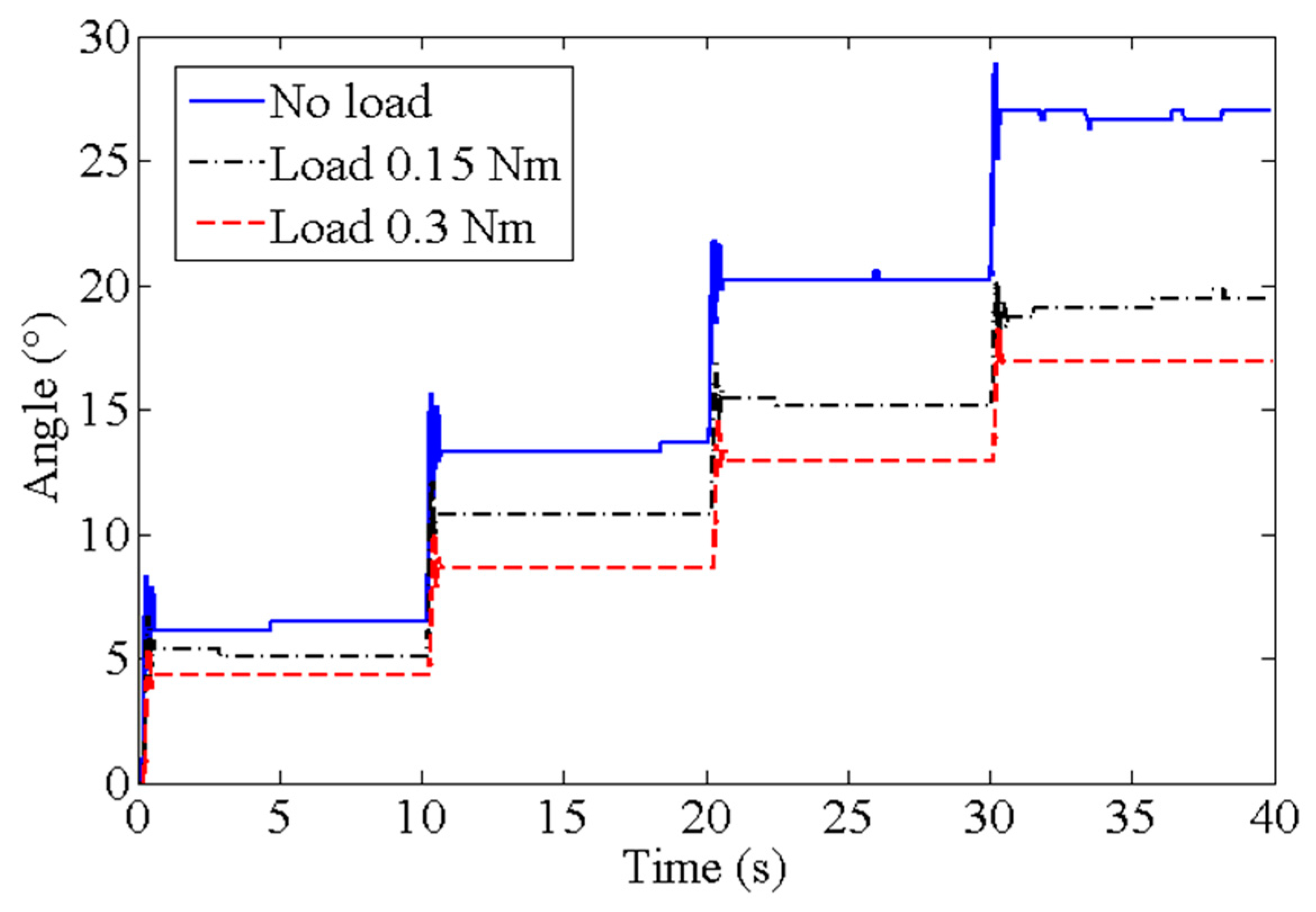
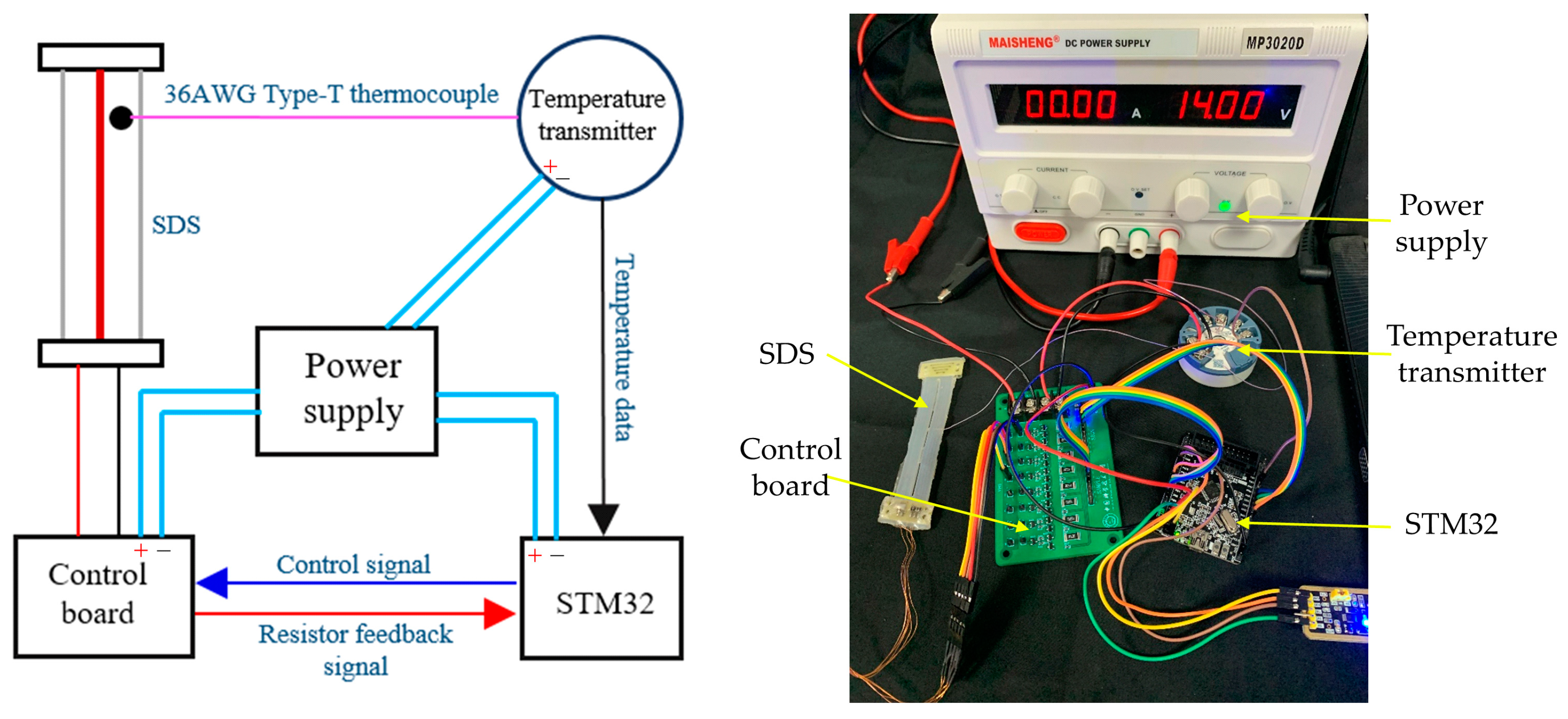
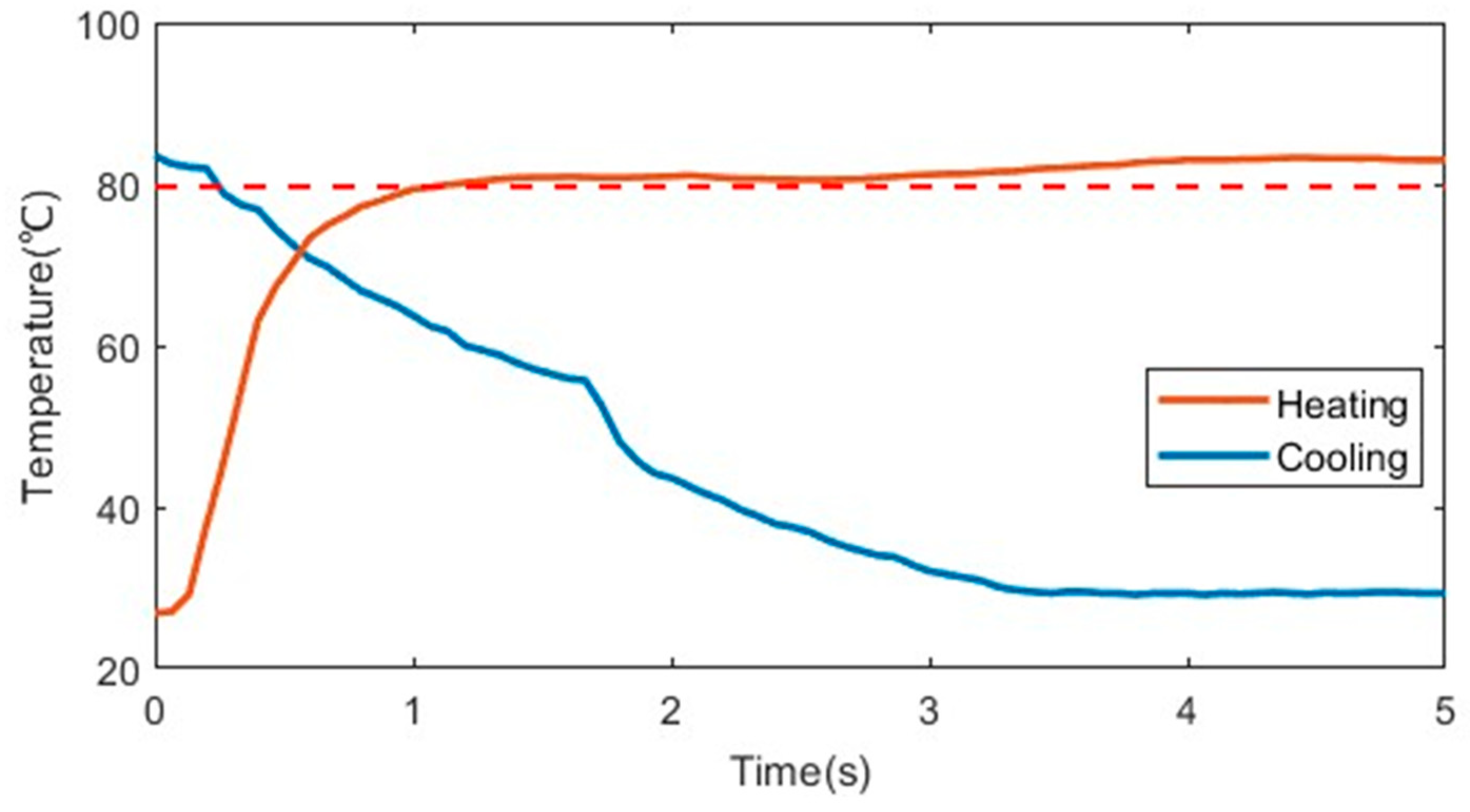
| Driving Number of SDSs | Simulation Angles | Dorsiflexion Angles | Plantarflexion Angles |
|---|---|---|---|
| 1 | 7.4° | 8.3° | 7.8° |
| 2 | 15.2° | 14.4° | 15.9° |
| 3 | 21.9° | 22.0° | 24.8° |
| 4 | 32.1° | 30.4° | 31.9° |
Disclaimer/Publisher’s Note: The statements, opinions and data contained in all publications are solely those of the individual author(s) and contributor(s) and not of MDPI and/or the editor(s). MDPI and/or the editor(s) disclaim responsibility for any injury to people or property resulting from any ideas, methods, instructions or products referred to in the content. |
© 2024 by the authors. Licensee MDPI, Basel, Switzerland. This article is an open access article distributed under the terms and conditions of the Creative Commons Attribution (CC BY) license (https://creativecommons.org/licenses/by/4.0/).
Share and Cite
Jia, Z.; Han, G.; Jin, H.; Xu, M.; Dong, E. Design and Force/Angle Independent Control of a Bionic Mechanical Ankle Based on an Artificial Muscle Matrix. Biomimetics 2024, 9, 38. https://doi.org/10.3390/biomimetics9010038
Jia Z, Han G, Jin H, Xu M, Dong E. Design and Force/Angle Independent Control of a Bionic Mechanical Ankle Based on an Artificial Muscle Matrix. Biomimetics. 2024; 9(1):38. https://doi.org/10.3390/biomimetics9010038
Chicago/Turabian StyleJia, Zhikun, Guangming Han, Hu Jin, Min Xu, and Erbao Dong. 2024. "Design and Force/Angle Independent Control of a Bionic Mechanical Ankle Based on an Artificial Muscle Matrix" Biomimetics 9, no. 1: 38. https://doi.org/10.3390/biomimetics9010038
APA StyleJia, Z., Han, G., Jin, H., Xu, M., & Dong, E. (2024). Design and Force/Angle Independent Control of a Bionic Mechanical Ankle Based on an Artificial Muscle Matrix. Biomimetics, 9(1), 38. https://doi.org/10.3390/biomimetics9010038





